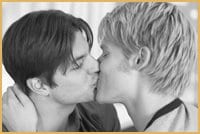Less than a decade ago, Ellen DeGeneres outed herself on her own TV sitcom and talking heads everywhere argued for months about what it meant for popular entertainment and the portrayal of gay people on TV. Queer as Folk, the sexually explicit series about gay men, aired it’s last episode Aug 15 and almost no one said a word.
To some, the fizzling passing of Queer as Folk is an indication of acceptance of queer people by the mainstream. Depictions of gay and lesbian characters, like portrayals of African-American and single mother role models on ’70s television, have proliferated on popular TV.
It was 25 years ago that Billy Crystal played a gay man on Soap and only five years ago that network TV showed its first romantic man-to-man kiss, on Dawson’s Creek.
That was when television shows had gay plot lines. Today, there are gay television shows. Some are big and successful like Will & Grace, others not very successful at all like John Goodman as a gay ex-husband and dad in Normal, Ohio.
Depictions of gay people on TV don’t seem to upset viewers the way they used to. Even those homo-haters who never liked seeing gays on TV kept their mouths shut during Queer as Folk’s run.
Once wacky next-door-neighbours and asexual sidekicks, gay TV characters are now so common that their sexual preferences have become invisible to most viewers. There have been gay parents on Roseanne, gay undertakers on Six Feet Under, gay doctors on Chicago Hope and ER, gay prisoners on Oz, gay teens on Degrassi: The Next Generation and even gay cartoon dogs on South Park.
Not only are queer characters cropping up like dandelions all over popular TV, but whole channels dedicated to gay people are taking to the air all over the world. Canada’s own OUTtv, formerly PrideVision, was the world’s first.
Gay men didn’t learn anything new from Queer as Folk. In fact, most of them preferred Sex and the City and The L Word instead. The show appealed mostly to straight women who were eager for a titillating peek into the sex and love lives of gay men.
In the end, Queer as Folk will be remembered for-of all things-a refreshing lack of controversy.
When the cast of Queer as Folk appeared on CNN’s Larry King Live there were surprisingly few crank calls. Ironically, the loudest media boycott in recent years was when gay organizations successfully put the screws to the homophobic Dr Laura Schlessinger’s show in 2000. After decades of being demonized or ignored, more diverse images of gay people on mainstream TV have allowed real-life queers to be recognized as an audience demographic; powerful enough to even merit our own TV commercials.
“Queer as Folk gave an appropriate amount of attention to the issue of HIV in gay men’s lives without getting preachy,” says Phillip Banks, Director of HIV Prevention and Awareness at AIDS Vancouver.
“It was an entertaining vehicle that dealt with important aspects of disclosure, stigma and discrimination, individual and community resilience, community support, treatment adherence issues, safer sex, magnetic sero-discordant couples, youth and HIV, and body image issues,” continues Banks.
He admits the show could have covered issues more deeply, in a more complex or comprehensive way but wonders if it would have been as entertaining. “I don’t know,” he says.
The consensus among straights and gays and everyone in-between is that the final season of Queer as Folk wasn’t as good as the previous one and that season wasn’t as good as the one that came before that. The humour became too subtle, the acting too earnest and the title song like finger nails on a chalk board.
The show had also become increasingly soap operatic. Michael was about to confess his feelings for Brian. No, wait. Justin was about to confess his feelings for Brian. These queer folks made you feel like a best friend lending a shoulder, or a spectator watching grains of sand passing agonizingly slowly through an hourglass-these are the relentlessly plodding days of our queer lives.
In the beginning, it might have been our show and our duty to watch it but by the final season, there wasn’t as much dissent among gay, lesbian and straight viewers as there was just plain indifference.
Banks doesn’t know if the show will be remembered as high quality television or not, but he says the characters were depicted in a way that demonstrated to the viewer the complex factors influencing a man’s values, behaviours, and attitudes. “Queer as Folk was certainly no Will & Grace,” he says. “Rather it provided an interesting balance to some of the criticisms of that show.”
Where Will is either blandly asexual or a gay man who doesn’t let his partner preference overpower his personality and Jack is either a swishy, ‘hey-girlfriend’ stereotype or an unabashedly femme queer guy, Brian Kinney was up-front, forthright, unapologetically promiscuous and usually kind of an asshole. He neither tap-danced nor compromised for anyone.
“In my view [that] was neither positive nor negative,” says Banks. “The very fact that a young gay guy could stay up and watch a sex-positive depiction of an unapologetically promiscuous character in a world where both homo-sex-and even more so promiscuity- are frowned upon was probably very liberating.”
Love it or hate it, Queer as Folk really was North America’s first series about queer people for queer people. It portrayed a more realistic diversity among queer people than anything that hit the mainstream before it. Without it there is no longer an all gay male drama on mainstream TV.

 Why you can trust Xtra
Why you can trust Xtra


